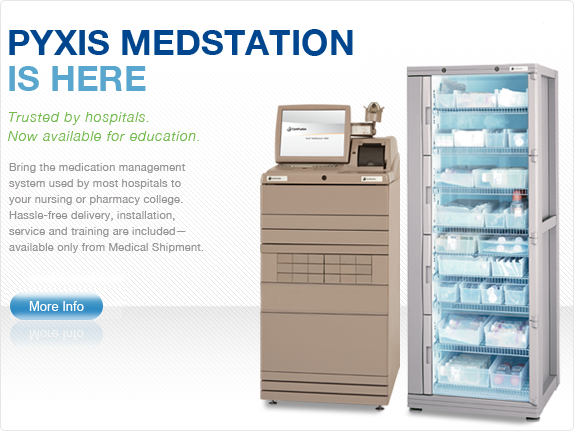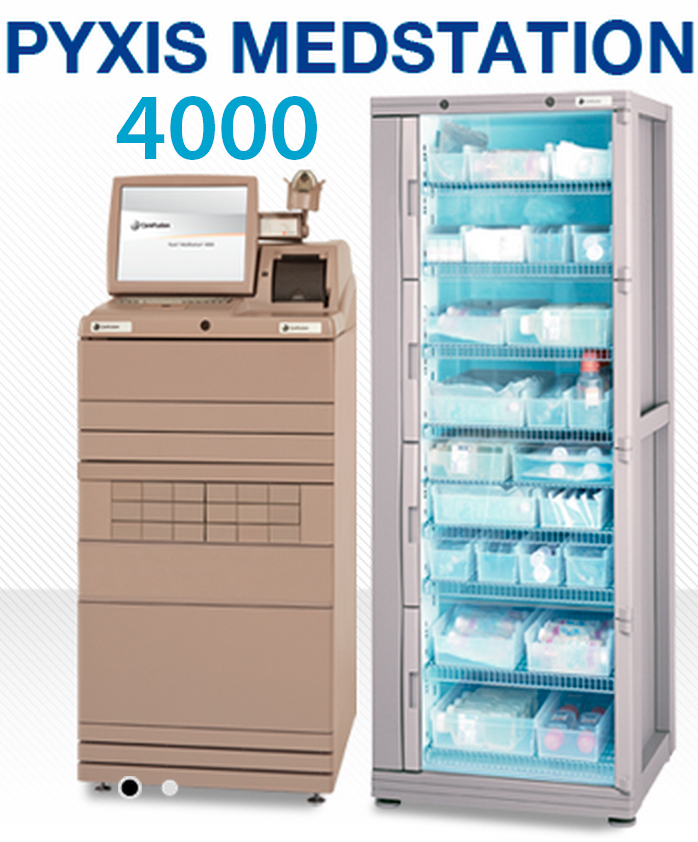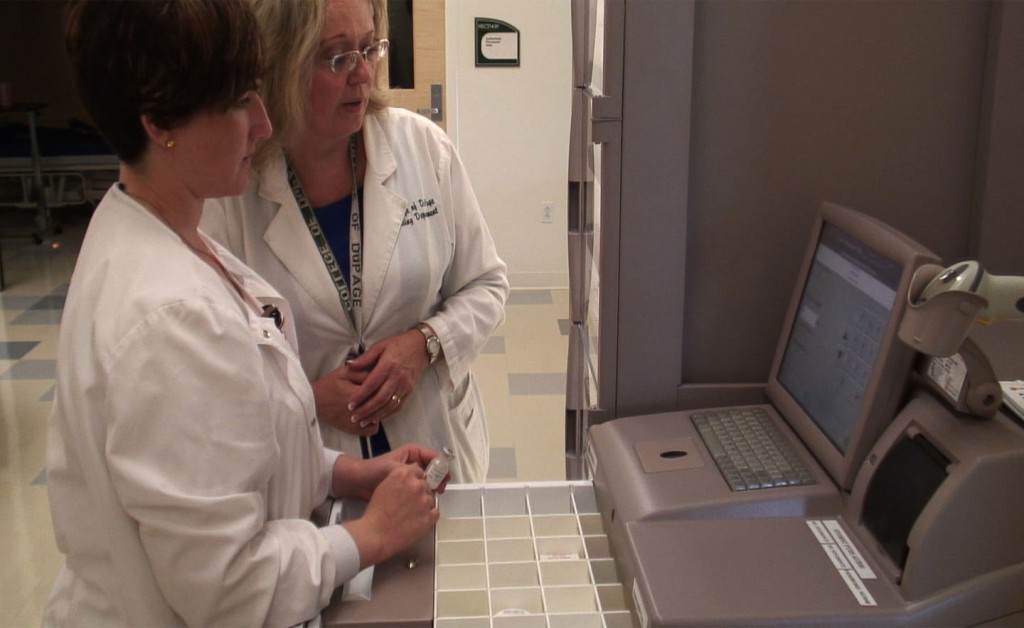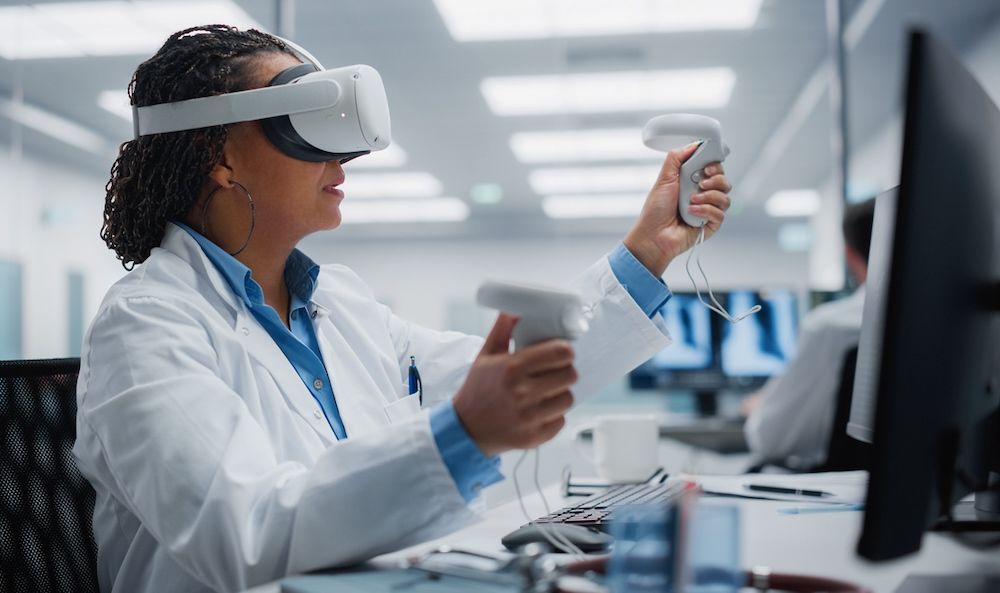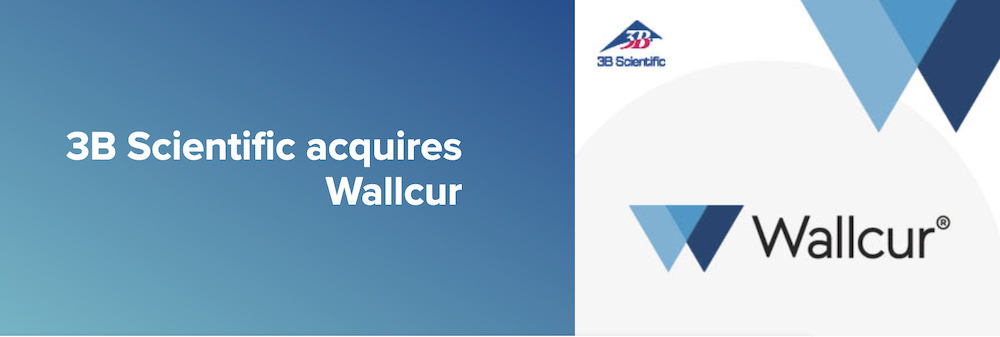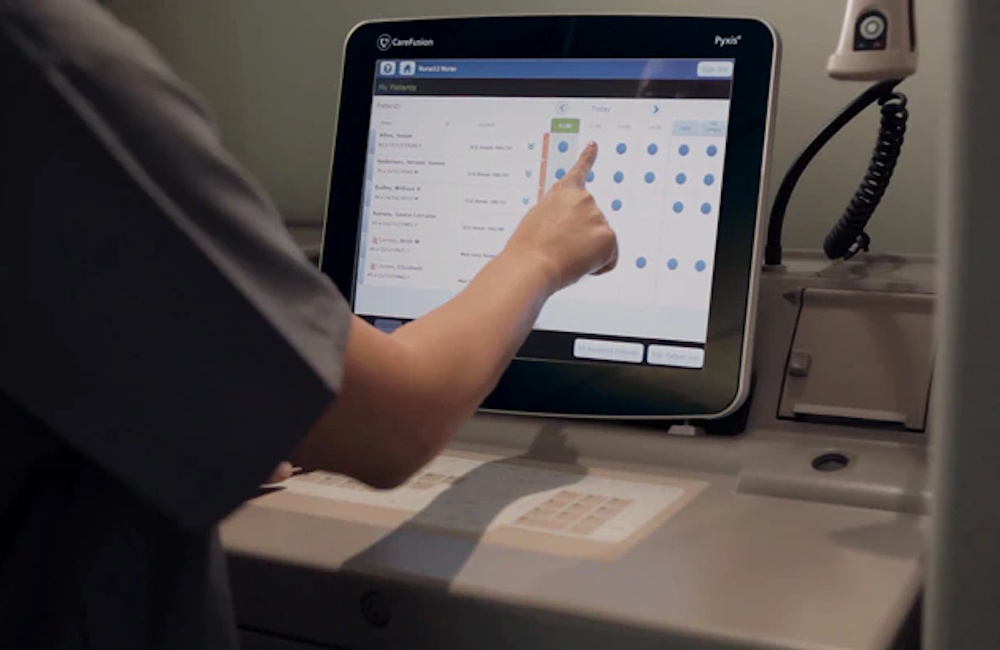Last month MedicalShipment.com, the exclusive educational distributer of CareFusion’s Pyxis Medstation 4000, sponsored my trip to the College of DuPage. Located just outside of Chicago, this Nursing school has been one of the first colleges to utilize the Pyxis Medstation in their Healthcare Simulation labs – with outstanding success! I am always a proponent of training with medical equipment that is as realistic as possible – and as the Pyxis is used in more than 50% of hospitals around the United States – the educational opportunities are undeniable. Watch part 1 of my video review of the Pyxis, which focuses on Nursing Educators, Lab Coordinators and Student reflections on this realistic medication administration device. Part 2 is available now which provides testimonials from the schools administrative and simulation technician staff.
Editors Note: The Pyxis MedStation 4000 has been replaced by the newer Pyxis MedStation ES
Lab Coordinator Donna Perchatsch RN, MSN sat down with me to talk about the installation, training and simulation lab use of the Pyxis device:
“I’m one of two lab techs here at the College of DuPage and I am responsible for the overall management of six laboratories including a simulation hospital and a simulation home health center. I was tasked with outfitting this new simulation hospital and I wanted to have an era of authenticity about what was in here to make it look real. I was at the INACSL 2012 conference, which I think was in San Antonio, and I ran into MedicalShipment – who we do have a business relationship with as they provide us with all of our medical supplies and have for the last three or four years. They had to Pyxis right there on the floor and I started playing with it and I realized –wow- this is exactly like what I use in the hospital.
In my research for buying this Pyxis I realized that there are three parts that are needed, one of the most important parts is the console. The console is a necessary component if you are interested in customizing your medications and your patients. I did have a couple of phone calls with outside schools who only had the tower and the actual Pyxis unit and they wanted to customize – but they couldn’t and that’s what actually let me to realize there was that third component that is necessary. Thankfully it’s very easy to use and we’re glad that we have it because we customize to all of our patients.
We had the training in January which was provided by a Pyxis analyst from CareFusion. The training instructor provided two full days, answered everything and was very patient when we had one-on-one training on the console and then back over to the Pyxis machine. The instructor showed us how to create a patient profile, how to put all of the medications in, how to add, how to delete, how to customize, how to add users using the biometric fingerprint entry. There were also oline modules that we could watch ahead of time up before we did the training and then also afterwards. He gave us numbers for the tech support and we’ve only had to contact them one time in the last ten months.
So we have another medication administration device and it didn’t work out for us and that led us to our researching the Pyxis. Now having it, I couldn’t imagine not having the Pyxis as it’s been wonderful and we love this Pyxis! This one is used every day, five days a week. We do simulation from seven in the morning, we do 7AM to 3PM shift and we do with 3PM to 11PM shift and so it is used around-the-clock, all day! We are definitely getting our money’s worth.
I believe the students really like having this Pyxis to use for their simulations because they know that this is what they see out in the real world. When they go to their clinicals, most hospital sites do have a Pyxis system and so this is something that is relevant and that they can use when they go for their first jobs – they can say “I know the Pyxis!”. “
College of DuPage Nursing Student Alison Dieter also chimed in about the career benefits of training on the Pyxis while still in school:
“As a student the Pyxis can initially be quite intimidating but it is actually pretty simple piece of machinery. I’ve used the Pyxis several times during our simulations and the good thing about the Pyxis is that it’s the same technology that we encounter in hospitals, versus just a regular medcart. When I do eventually land that perfect job I’ll have the knowledge gained from the hands-on training here through the Pyxis that can directly be applied to any job as a nurse.
Every clinical site that I’ve been to uses the Pyxis and I believe they are probably going to implement that in the future to the hospitals that don’t use that right now. So the knowledge that we gain from the Pyxis here in our simulation labs is invaluable as far as a applied to real-world scenarios as a nurse.”
Lastly for Part 1 of this video series, I sat down with Assistant Professor and Nursing Coordinator Theresa Bucy MSN, RN, CNE to talk about the clinical outcomes associated with utilizing the Pyxis:
“Well when we first decided to use Pyxis, we went with something “other than”, let’s just say. That product just didn’t create the level of real clinical experience that the students are going to encounter in the clinical setting. So when the opportunity came to actually purchase a Pyxis – we are very excited. I’ve worked with the Pyxis in the clinical setting for probably eight years or so and so when it was here on our unit — I say our unit because this lab feels very real to me — but here in our Sim hospital there was no getting used to it. I just needed to know how our passwords work here versus how they work in a hospital, so that was great.
The IOM report that came out and the subsequent instructions to nurse educators that came out of that, were that nursing graduates are not hitting the ground running. So what this does, in my opinion, is it allows the students to “so to speak” hit the ground running when they get to the clinical setting. New graduates demonstrate some confidence and competence right up front that kind of gives the hospital staff some confidence in the new grads as they assume their new role in the clinical setting. That’s what I love most about it.
With regard to the learning outcomes what I like about the Pyxis is that it helps learners think in terms of: first they enter their own identity, then they choose a patient, and then match their patient to the orders. The Pyxis gets learners thinking in that orderly fashion. I guess because it’s a machine it can’t let learners deviate and so it helps them to realize the priority that they need to work through. Another thing that the Pyxis does, that some other types of systems don’t do automatically, is it has a narcotic check that counts certain medications. This gives us an opportunity to teach students how we as nurses on the unit interact with the pharmacy in making sure that certain counts remain where they need to be.
One of the other things I enjoy about Pyxis is we are able to take the products that we’ve adopted which are the Elsevier simulated learning experiences (SLS). We use those patient names as the names that we put into the Pyxis and those medications from the profiles in those products and put them into the Pyxis. That way we are able to go ahead and develop our scenarios and incorporate the Pixies in the simulation and the learning outcomes for the students.”
When I asked Theresa “So would you recommend the Pyxis MedStation 4000 from MedicalShipment.com to other Nurse Educators?” she replied:
“I would! I would recommend the Pyxis to other nurse educators. I have to take a look at their learning outcomes but I can’t believe that they wouldn’t be able to use this to prepare their students for the real-life clinical experiences that they’re going to see out in practice. I would recommend it.”
To learn more watch part 2 of the video series, and visit MedicalShipment.com!

